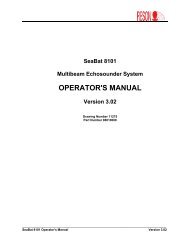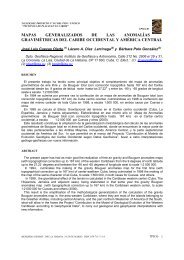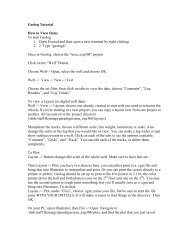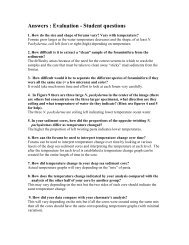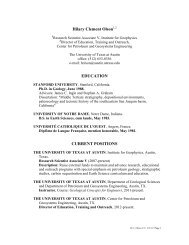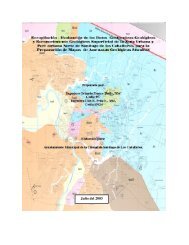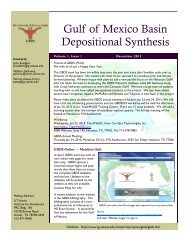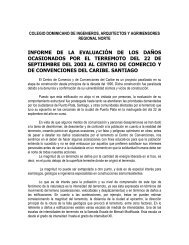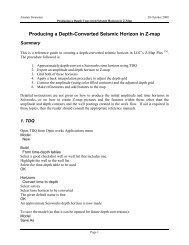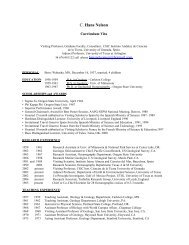IGCP Project short title: Caribbean Plate Tectonics Duration and ...
IGCP Project short title: Caribbean Plate Tectonics Duration and ...
IGCP Project short title: Caribbean Plate Tectonics Duration and ...
Create successful ePaper yourself
Turn your PDF publications into a flip-book with our unique Google optimized e-Paper software.
4<br />
is a major issue concerning the geology of the <strong>Caribbean</strong> plate, because the presence of a<br />
Central American mid-Cretaceous arc will reduce the rate of relative eastward movement of<br />
the <strong>Caribbean</strong> plate respect to North <strong>and</strong> South America, <strong>and</strong> would have a strong bearing on<br />
the palinspastic reconstruction of the circum-<strong>Caribbean</strong> fold-belts.<br />
Tectonic position of the Cuban Southwestern terrains (CSWT). Many early plate<br />
tectonic models of the <strong>Caribbean</strong> ignored the CSWT, but fortunately, they have been taken<br />
into account in more recent versions (Lawver et al., 1999). However, as demonstrated by the<br />
lively discussion at the Havana meeting in March 2001, the geology of the CSWT is still too<br />
poorly known to be interpreted without ambiguity. More field <strong>and</strong> laboratory research<br />
focused on the petrology <strong>and</strong> internal structure of the Socorro (Grenvile), Escambray, Purial<br />
<strong>and</strong> Pinos metamorphic terrains, as well as on the stratigraphy <strong>and</strong> tectonic position of the<br />
Placetas <strong>and</strong> Rosario belts (terrains) are urgently required before a fair interpretation of the<br />
origin of these geologic units can be reached. Available P-t path studies, isotopic dating <strong>and</strong><br />
geochemical data for the Escambray <strong>and</strong> Purial are still insufficient.<br />
The Great Arc vs Multiple Arc concept. Pindell’s <strong>Caribbean</strong> models show a single<br />
“Great Arc” evolving from Cretaceous to recent as the leading edge of the <strong>Caribbean</strong> plate<br />
progressively occupy the space created by the separation of North <strong>and</strong> South America<br />
(Pindell, 1994; Mann, 1999). Another concept is that there were multiple arcs that evolved<br />
step by step from Cretaceous to Recent (Iturralde-Vinent, 1994, 1998, WebPage Forum).<br />
The Multi Arc concept evolves from the following ideas:<br />
a. The occurrence of several magmatic <strong>and</strong> stratigraphic gaps within the Greater Antilles-<br />
Lesser Antilles volcano-sedimentary sections <strong>and</strong> the presence of unconformities at different<br />
time intervals on the various isl<strong>and</strong>s.<br />
b. Modification of the geochemistry of the arc magmatism after some of these gaps,<br />
especially in Cuba (Iturralde-Vinent, 1994, 1998). However this does not apply to all of the<br />
tectonic breaks in Puerto Rico (Jolly et al , 1998}.<br />
c. Modification of the orientation <strong>and</strong> geographic distribution of the arc magmatic axis after<br />
each gap, but specially after the earliest Cretaceous boninite <strong>and</strong> IAT arc, <strong>and</strong> after the<br />
Cretaceous arc (Kyzar, G., 2001: PhD Thesis: The George Washington University).<br />
The Geometry of the Arcs. During the meetings in Rio de Janeiro, Stuttgart, <strong>and</strong><br />
Cuba the geometry of the arc was the subject of consideration. A debate arose concerning<br />
the characteristics of the Greater Antilles- Aves Ridge- Lesser Antilles Cretaceous-<br />
Paleogene volcano-sedimentary complexes <strong>and</strong> the fact that the components of the original<br />
arcs (backarc, axial arc, front arc, subduction suture) are not evident in any cross-section of<br />
the present-day isl<strong>and</strong>s. The issue is that the arcs have been deformed by combined<br />
thrusting, extension along the axis, <strong>and</strong> were subsequently subdivided into distinct terrains<br />
that were the subject of rotation <strong>and</strong> eastward transportation. Consequently, the original<br />
4



